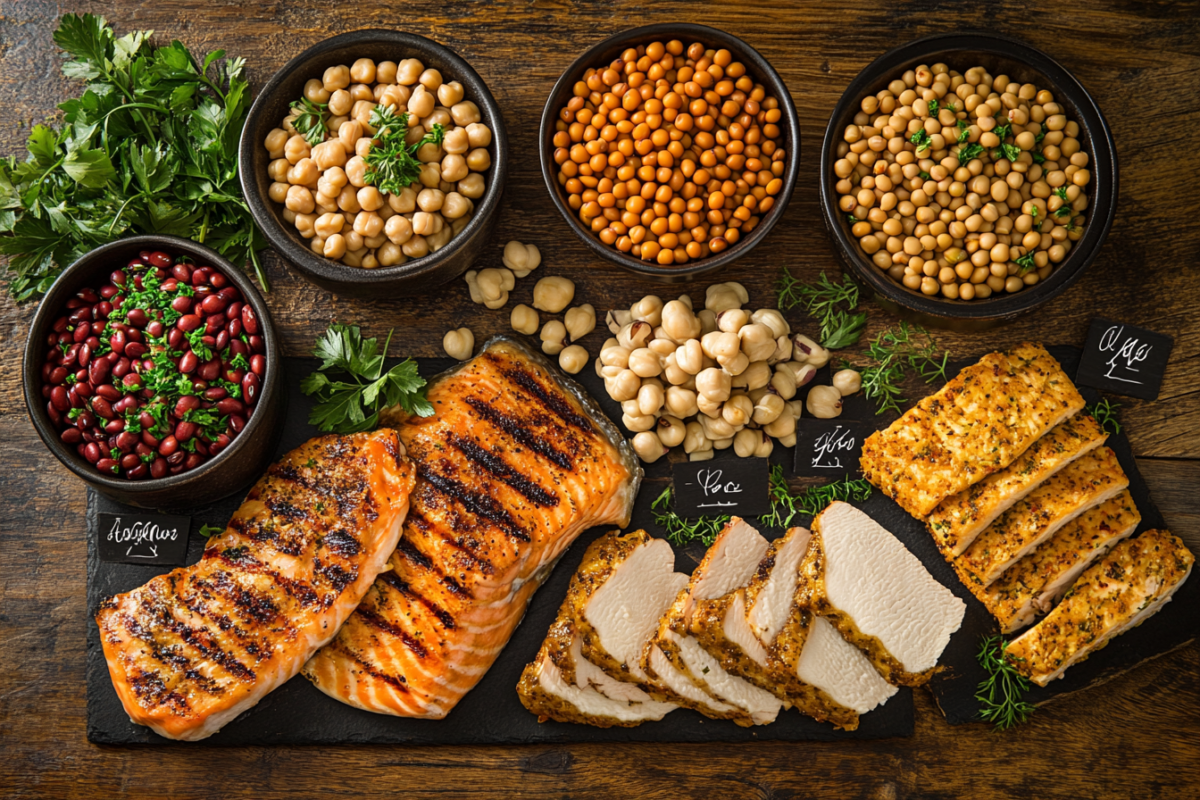Ground beef is a staple in many households, known for its versatility and delicious taste. But have you ever wondered about the exact nutritional value of 1/2 cup ground beef protein? This article dives into the details, unraveling the protein content, how it compares to other foods, and how cooking methods impact its nutritional profile. We’ll also explore the health benefits, potential concerns, and even some FAQs to answer all your burning questions about this protein-packed food.
Introduction to Ground Beef and Its Nutritional Importance
What Is Ground Beef?
Ground beef is simply beef that’s been finely chopped or processed into small pieces, making it easy to use in various dishes. It typically comes in different fat-to-lean ratios, such as 80% lean or 95% lean, which directly affect its texture and nutritional value.
Why Protein Content Matters
Protein is an essential nutrient for building and repairing tissues, supporting muscle growth, and maintaining overall health. For those looking to include ground beef protein in their diet, knowing its exact protein content can help make smarter dietary choices.
Understanding Protein Content in Ground Beef
Protein Content in 1/2 Cup of Ground Beef
When you’re eyeing a hearty meal, it’s crucial to understand exactly how much protein you’re getting from 1/2 cup ground beef protein. Typically, a 1/2 cup of cooked, lean ground beef provides around 20 grams of protein. But, this can vary depending on several factors like the fat percentage and cooking method. Understanding these nuances can help you better align your nutritional intake with your goals.
Raw vs. Cooked Ground Beef
It’s important to note that the protein content in raw ground beef is different from its cooked counterpart. Why? Well, when meat is cooked, it loses some of its water content, causing the protein concentration to increase.
Protein in Raw Ground Beef
In raw ground beef, you might find that a 1/2 cup of meat contains approximately 13–15 grams of protein. The exact amount depends on the fat ratio in the ground beef. If you’re looking to reduce fat intake while maximizing protein, leaner cuts like 93% or 95% lean ground beef are great options.
Protein in Cooked Ground Beef
Once cooked, the protein in ground beef becomes more concentrated. A 1/2 cup of cooked ground beef generally contains around 20 grams of protein. The cooking method can slightly alter this figure, but the difference isn’t typically substantial.
Impact of Fat Percentage on Protein Content
Another factor that affects ground beef protein is the fat percentage. The leaner the ground beef, the higher the concentration of protein. Here’s a quick breakdown of how different fat percentages impact protein content:
73% Lean Ground Beef
At 73% lean, ground beef is higher in fat and lower in protein. You can expect about 15–17 grams of protein per 1/2 cup cooked. It’s flavorful but not the best option for those prioritizing protein over fat.
80% Lean Ground Beef
With 80% lean ground beef, you’ll get around 18–19 grams of protein per 1/2 cup cooked. It strikes a balance between fat and protein, making it a popular choice for many recipes.
93% Lean Ground Beef
At 93% lean, you get a higher protein-to-fat ratio, providing around 20 grams of protein per 1/2 cup cooked. This is a great option for those who want a leaner meal without sacrificing too much flavor.
95% Lean Ground Beef
95% lean ground beef is the leanest option, offering around 21 grams of protein per 1/2 cup cooked. This is ideal for those aiming for a low-fat, high-protein meal.
Nutritional Profile of Ground Beef
Comprehensive Nutritional Breakdown
Ground beef isn’t just a great source of protein—it’s also packed with essential nutrients that contribute to overall health. By understanding its macronutrient and micronutrient breakdown, you’ll get a fuller picture of how this meat fits into a balanced diet.
Macronutrients
Proteins
As mentioned earlier, protein is one of the standout nutrients in ground beef. This macronutrient plays a crucial role in building and repairing tissues, producing enzymes and hormones, and maintaining muscle mass. A typical serving of 1/2 cup ground beef protein provides about 20 grams of high-quality protein. This makes it an excellent option for people looking to build muscle or simply meet their daily protein needs.
Fats
Ground beef is known for its fat content, which can vary depending on the lean-to-fat ratio. For example, 80% lean ground beef contains about 23 grams of fat per 1/2 cup cooked, while leaner cuts like 95% lean beef have around 10 grams of fat. Fat isn’t all bad—it’s necessary for energy, hormone production, and supporting cell structure. However, moderation is key. To limit your intake of saturated fat, you can opt for leaner cuts like 93% or 95% lean ground beef.
Carbohydrates
Ground beef is virtually carbohydrate-free, which makes it an excellent option for those following low-carb diets such as keto. It doesn’t contain any fiber either, so if you’re looking for fiber-rich foods, consider pairing ground beef with vegetables or whole grains.
Micronutrients
Vitamins
Ground beef is a rich source of several essential vitamins. These include:
- Vitamin B12: Crucial for nerve function and red blood cell production
- Vitamin B6: Supports brain health and metabolism.
- Niacin (Vitamin B3): Helps convert food into energy and supports healthy skin.
- Riboflavin (Vitamin B2): Essential for energy production and cell function.
Minerals
In addition to vitamins, ground beef provides a wealth of minerals:
- Iron: Particularly heme iron, which is highly absorbable and supports red blood cell production.
- Zinc: Crucial for immune function, wound healing, and DNA synthesis.
- Phosphorus: Supports bone health and the formation of teeth.
- Selenium: Acts as an antioxidant and contributes to thyroid function.
Caloric Content
Caloric content can vary depending on the fat content in ground beef. Here’s a quick breakdown for a 1/2 cup cooked serving:
- 73% lean: Approximately 290 calories
- 80% lean: Approximately 250 calories
- 93% lean: Approximately 200 calories
- 95% lean: Approximately 190 calories
Health Implications of Consuming Ground Beef
Health Benefits
High-Quality Protein Source
One of the main reasons people turn to ground beef is its rich protein content. As discussed, a 1/2 cup serving of cooked ground beef provides about 20 grams of high-quality protein. This is essential for building muscle, repairing tissues, and producing hormones and enzymes. Unlike some plant-based protein sources, beef protein contains all the essential amino acids your body needs, making it a complete protein.
Rich in Essential Nutrients
Beyond just protein, ground beef offers several other vital nutrients. It is a good source of iron, particularly heme iron, which is more easily absorbed by the body than plant-based iron. This makes it an excellent option for those at risk of iron deficiency, such as pregnant women or individuals with certain health conditions. Additionally, ground beef provides zinc, vitamin B12, and phosphorus, all of which play critical roles in supporting immune function, energy production, and bone health.
For those seeking a nutrient-dense food that can help meet their daily nutritional requirements, ground beef can be an excellent choice. With its mix of protein, vitamins, and minerals, it supports overall health, boosts metabolism, and aids in the proper functioning of various bodily systems.
Potential Health Concerns
Saturated Fat Content
While ground beef is undoubtedly packed with protein, it’s also high in saturated fat, especially in fattier cuts like 73% lean beef. Saturated fat has long been linked to an increased risk of heart disease, as it can raise LDL (bad) cholesterol levels in the blood. If you’re concerned about your saturated fat intake, consider opting for leaner ground beef options, such as 93% or 95% lean.
Cholesterol Levels
Along with its saturated fat content, ground beef can also contribute to higher cholesterol levels. For individuals already at risk of high cholesterol or heart disease, it’s important to be mindful of the types of beef consumed. Leaner cuts are better options for those trying to maintain healthy cholesterol levels while still enjoying beef as a source of protein.
Processed vs. Unprocessed Ground Beef
There’s a distinction between unprocessed ground beef and processed beef products, such as sausages or deli meats. Processed meats are often higher in sodium, preservatives, and unhealthy fats. These products have been linked to an increased risk of certain diseases, including colorectal cancer. On the other hand, unprocessed ground beef is a more natural, nutrient-dense option. To maximize health benefits, choose minimally processed cuts of ground beef and avoid heavily processed varieties.
Comparing Ground Beef to Other Protein Sources

Animal-Based Proteins
Chicken
Chicken, particularly chicken breast, is one of the most popular animal-based protein sources, offering a lean alternative to ground beef. A 3-ounce serving of cooked chicken breast provides about 25 grams of protein, which is slightly more than the 20 grams in 1/2 cup of ground beef. However, chicken has much less fat than beef, especially when skinless. This makes it a great option for those looking to reduce their fat intake while still getting plenty of protein.
The trade-off? While chicken is lower in fat, it doesn’t offer the same rich nutritional profile as beef. Ground beef provides more iron and zinc, essential for maintaining healthy blood and immune function, respectively. Depending on your dietary needs, switching between chicken and beef can offer variety and balance in your meals.
Fish
Fish, especially fatty fish like salmon, tuna, and sardines, are excellent sources of protein with the added benefit of omega-3 fatty acids. A 3-ounce serving of salmon provides about 22 grams of protein and offers numerous health benefits, such as reducing inflammation and improving heart health. Fish is lower in saturated fat than ground beef, and the omega-3s help reduce the risks associated with heart disease.
However, fish doesn’t offer the same levels of iron and zinc as ground beef, so while it’s a fantastic option for overall health, you might want to include ground beef or other animal proteins in your diet for the additional micronutrients.
Plant-Based Proteins
Legumes
Legumes such as lentils, chickpeas, and beans are fantastic plant-based protein sources. They contain around 18–25 grams of protein per cup when cooked, making them a great alternative to ground beef for vegetarians and vegans. Unlike animal-based proteins, legumes are packed with fiber, which promotes digestive health and helps maintain stable blood sugar levels. They also provide essential vitamins and minerals, like folate and iron.
However, plant proteins like legumes aren’t “complete” proteins, meaning they don’t contain all the essential amino acids your body needs on their own. Pairing legumes with whole grains or other plant proteins can create a balanced protein source that rivals the amino acid profile of meat.
Tofu and Tempeh
Tofu provides about 10 grams of protein per 1/2 cup, while tempeh packs in about 15 grams of protein per 1/2 cup. Both are versatile and absorb the flavors of the dishes they’re cooked in, making them great substitutes for ground beef in a variety of recipes.
While they offer substantial protein, tofu and tempeh don’t provide the same depth of iron and zinc as ground beef. However, they’re lower in fat and don’t carry the same cholesterol concerns, making them excellent choices for heart health-conscious individuals.
Seitan
Seitan, also known as wheat meat, is another high-protein meat substitute. It contains about 21 grams of protein per 3 ounces, which is comparable to lean ground beef. Seitan is made from gluten, the protein in wheat, and is often used in vegan and vegetarian dishes as a meat replacement due to its meaty texture.
While it’s a great source of protein, seitan lacks some of the key nutrients found in ground beef, like iron and vitamin B12. Additionally, because it’s made from wheat, it’s not suitable for individuals with gluten sensitivities or celiac disease.
Cooking Methods and Their Impact on Protein Content
Effect of Cooking on Protein Levels in Ground Beef
When it comes to ground beef, cooking methods significantly impact its protein content. Raw ground beef contains a certain amount of protein, but as the meat cooks, it loses water content, which makes the protein become more concentrated. For instance, a 1/2 cup of raw ground beef will have less protein than the same amount of cooked beef, due to the loss of moisture during cooking.
However, the cooking method can also influence how much protein is retained. For example, grilling or broiling allows fat and juices to drip off, while frying can trap more fat, potentially altering the protein-to-fat ratio. This means that while the absolute amount of protein might remain similar, the overall nutritional profile can shift depending on the cooking method.
Grilling Ground Beef and Its Effect on Protein Retention
Grilling ground beef allows excess fat to drip off, making it one of the healthiest cooking methods. This method results in a leaner, more protein-packed end product since it helps retain the protein in ground beef and minimizes additional fat.
Boiling Ground Beef for Maximum Protein Preservation
Boiling ground beef involves cooking it in water, which causes some of the nutrients, including protein, to leach into the water. However, this method tends to keep the protein content intact better than frying, making it another healthy cooking option for those looking to preserve ground beef’s protein content.
Frying Ground Beef and Its Impact on Protein Levels
Frying ground beef can increase the fat content significantly, but it doesn’t drastically affect the protein content. The biggest difference here is that fried ground beef might contain added oils, which increase the calorie and fat count without increasing protein.
Tips to Preserve Protein Content in Ground Beef While Cooking
If you’re aiming to preserve as much protein as possible in your ground beef, here are a few tips to keep in mind:
- Avoid Overcooking Ground Beef: Overcooking ground beef can lead to a loss of moisture, which can affect its protein concentration. Cook your ground beef just until it’s no longer pink inside to retain as much protein as possible.
- Use Gentle Cooking Methods for Maximum Protein Retention: While grilling is great for fat reduction, boiling or steaming ground beef can help maintain its nutritional integrity without excessive fat.
- Drain Excess Fat from Ground Beef: If you choose to fry ground beef, make sure to drain the excess fat after cooking. This will help keep the protein-to-fat ratio balanced.
- Opt for Leaner Ground Beef Cuts: Using lean ground beef will naturally increase protein density per serving, as it has less fat to offset the protein.
FAQs About Ground Beef Protein Content
How much protein is in 1/2 cup of cooked ground beef?
A 1/2 cup of cooked ground beef contains approximately 20 grams of protein. The exact amount can vary slightly depending on the fat content, with leaner cuts offering slightly more protein.
Does the fat percentage in ground beef affect its protein content?
While the fat percentage affects the overall nutritional profile, it doesn’t drastically change the protein content of ground beef. However, leaner cuts like 93% or 95% lean ground beef provide more protein per serving since there’s less fat.
Is ground beef a good source of protein compared to chicken?
Ground beef is a high-quality protein source, but chicken often provides slightly more protein per ounce (around 25 grams per 3 ounces) compared to the 20 grams in 1/2 cup of cooked ground beef. Both are excellent sources, so it’s worth incorporating both into your diet for variety.
How does cooking method impact the protein content in ground beef?
Cooking methods like grilling or boiling can help retain more protein by allowing excess fat and water to escape. Frying may result in more fat being absorbed, which could slightly reduce the protein-to-fat ratio.
What are healthier alternatives to ground beef for protein?
If you’re looking for a healthier protein source, consider leaner animal proteins like chicken or turkey, or plant-based options like tofu, tempeh, and legumes. These options can provide high-quality protein while potentially offering fewer saturated fats.
Final Thoughts on Including Ground Beef in a Balanced Diet for Protein
Ground beef can absolutely be part of a balanced diet when consumed in moderation and in leaner forms. It provides essential protein, iron, and other vitamins and minerals that support overall health. However, balancing it with other protein sources, such as chicken, fish, or plant-based alternatives, can offer a more diverse nutrient profile and help reduce risks associated with high saturated fat intake. Keep your cooking methods in mind, opt for leaner cuts, and enjoy the nutritional benefits ground beef has to offer!

